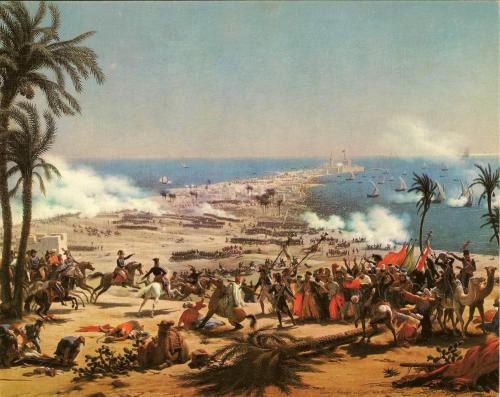peashooter85:Napoleon in Egypt Part IV —- The Last CrusadeClick for parts I, II, and IIIAfter brutal
peashooter85:Napoleon in Egypt Part IV —- The Last CrusadeClick for parts I, II, and IIIAfter brutally suppressing a revolt in Cairo, Napoleon’s hold over Egypt was still shaky at best. Yet things were about to get a lot worse when the Ottoman Empire sent an army in retaliation for the invasion of Egypt. The Ottoman Empire organized a massive army, conscripting troops from all over the Middle East; Turkey, Iraq, Syria, and Jerusalem, as well as soldiers from Greece and the Balkans. Altogether, the Ottoman Army totaled over 80,000 men. By contrast Napoleon barely had 20,000 battle ready men. To shore up the numbers Napoleon recruited sailors, leftovers of his doomed fleet destroyed by Adm. Nelson, and retrained them as infantrymen. Napoleon also conscripted native troops from Egypt’s slave populace.A common theme of the Napoleonic Wars, whenever Napoleon was outnumbered or surrounded, he went on the offensive. On the 5th of February, 1799, Napoleon’s army invaded Palestine. It was the first time a Christian European army had invaded the Holy Land since the Crusades of the Middle Ages. Like the Crusades, the campaign was doomed to failure.Marching deep into the Levant, Napoleon saw early successes as he occupied Gaza and Jaffa. Though heavily fortified, the Ottoman defenders were no match for the professional French Army. Ottoman counterattacks were swiftly beaten back through Napoleons brilliant tactics. Thousands of Ottoman soldiers were killed, thousands more were executed as Napoleon’s army was in no shape to take and handle prisoners.Napoleon’s goal was to take the city of Damascus in Syria, one of the largest and wealthiest cities in the Middle East. However the campaign came to a snag when the army reached the ancient fortified city of Acre, located on the coast of what is now Northern Israel. Once a bastion of the Crusaders, Acre was so heavily fortified that it was the last Crusader outpost to fall during the Crusades. Now Napoleon had no choice to besiege it, lest he expose his rear on his march to Damascus. Unfortunately Napoleon only had 80 small cannon that were insufficient for siege work.At first Napoleon attempted to take the city with his infantry, believing that Acre would quickly capitulate. He was very wrong. The French Army was forced lay siege to Acre, a siege that would last over 60 days. Despite Napoleons best laid plans and courageous fighting on the part of the French, the fortifications of Acre were too strong. As the French laid siege to Acre, they also had to contend with Ottoman counterattacks from Damascus, and harassment by local guerrilla forces. Worse yet, the Ottomans in Acre received aide from Britain as the Britain Navy shipped in supplies, cannon, and reinforcements in the form of Royal Marines. Napoleon’s army, however, was far from it’s supply lines and growing weaker by the day. The only relief came when a French fleet was able to sneak in siege cannon to Napoleon.As Ottoman forces within Acre grew stronger, Napoleon’s forces grew weaker. Then the worst happened, a virulent strain of the plague swept throughout the French Army. Thousands were sickened, reducing Napoleon’s ranks even further. Eventually it came to the point that Napoleon’s Army could no longer maintain the siege, especially when an Ottoman fleet appeared on the horizon with a large relief force. In May of 1799, after a three month campaign in the Holy Land, Napoleon was forced to call retreat.To be continued… -- source link
Tumblr Blog : peashooter85.tumblr.com


